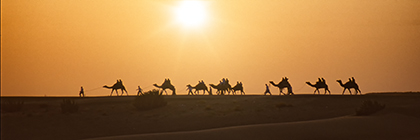Viele von uns haben schon die Nase voll von Kälte und Schnee. Ich gehöre da nicht dazu! Ich liebe den Winter mit viel Schnee und Kälte. Es gelingen die besten Fotos, wenn ich bei frostigen Temperaturen durch unberührte Schneefelder stapfe, die funkeln als wären sie mit abermilliarden Diamanten bestreut. Gegen Kälte kann ich mich schützen, gegen Hitze nur bedingt. Das geht mir durch den Kopf, als ich an diesem Panorama den Monats arbeite und es für das Web aufbereite. Es ist schon ein paar Jahre her, dass ich munterseelenalleine das nördliche Indien bereiste. D.h. alleine ist man in Indien nie, dafür sorgen über 1,3 Milliarden Bürger des Subkontinents. Draußen aber, in der Wüste Thar, da bist du alleine, mit all den Schönheiten, Naturgeheimnissen und auch Gefahren. Mein Rucksack war vollgestopft mit meiner Fotoausrüstung, einem Fünfliter-Wasserkanister, einem weißen Leinentuch für Kopf und Schultern als Schutz gegen die Sonne und einem Kompass. So marschierte ich los in die Wüste Thar hinein, nicht der Selbstfindung wegen, sondern, um Fotos von der Wüste, deren Bewohnern und vor allem dem spektakulären Sternenhimmel zu machen. Ich hatte lediglich zwei Tageswanderungen und eine Übernachtung in dieser einsamen Wildnis eingeplant. Ich musste mir den Wasservorrat gut einteilen. Zweieinhalb Liter pro Tag, das ist nicht viel, bei Tagestemperaturen um die vierzig Plusgrade. Fünf Liter Wasser sind fünf Kilo, dazu noch eine immens schwere Fotoausrüstung, das geht in´s Kreuz. Womit ich allerdingsnicht gerechnet hatte, waren die enormen Temperaturschwankungen. Ich wusste zwar, dass es in der Nacht kalt sein kann, aber mit dieser Eiseskälte hatte ich nicht gerechnet. Wie gesagt, gegen Kälte kann man sich schützen, wenn man entsprechende Kleidung dabei hat ... und die hatte ich nicht dabei. So fror ich mich durch die Nacht, als Gegenleistung bekam ich schöne Wüstenfotos mit Sternenhimmel. Am nächsten Tag, ich befand mich bereits auf dem Rückweg in die Zivilisation, sah ich in einiger Entfernung eine Kamelkarawane. Die wollte ich natürlich fotografieren. Allzuviel Zeit blieb mir nicht. Die Sonne stand schon sehr tief und in Äquatornähe sinkt sie viel schneller als in unseren Breitengraden. Wie es aber in der Wüste so ist. Du denkst in dreißig Minuten bin ich dort und wunderst dich nach einer Stunde, dass du das Ziel noch immer nicht erreicht hast. Ich kramte im Rucksack, holte das 400 mm Tele hervor, schaltete an der Kamera den Cropfaktor ein und hatte so ein 600er. Mit dieser Einstellung fotografierte ich auch das Panorama, was gar nicht so leicht war. Ich bräuchte mindestens drei überlappende horizontale Aufnahmen, die Karawane bewegte sich aber weiter. Irgendwie ist es dann doch gelungen. Die riesige Telebrennweite vergrößerte die Sonne was die Wüstenhitze und den Charakter dieser Landschaft betonte. In jeder Hinsicht ein gelungenes Panorama.
Many of us are already fed up with the cold and snow. I don't belong there! I love winter with lots of snow and coldness. The best photos come out when I trudge through pristine snowfields in freezing temperatures that sparkle as if they were sprinkled with billions and billions of diamonds. I can protect myself against the cold, but only to a limited extent against the heat. That's what's going through my mind as I work on this Panorama of the Month and prepare it for the web. It's been a few years since I traveled around northern India all by myself. This means that you are never alone in India, thanks to over 1.3 billion citizens of the subcontinent. But outside, in the Thar desert, there you are alone, with all the beauties, natural secrets and also dangers. My backpack was stuffed with my photographic equipment, a five-liter water can, a white linen towel for my head and shoulders to protect against the sun, and a compass. So I marched off into the Thar Desert, not for the sake of self-discovery, but to take photos of the desert, its inhabitants and, above all, the spectacular starry sky. I had only planned two day hikes and an overnight stay in this lonely wilderness. I had to manage the water supply well. Two and a half liters a day, that's not much, with daytime temperatures of around forty degrees. Five liters of water are five kilos, plus immensely heavy photographic equipment, it gets in the back. What I hadn't expected, however, were the enormous temperature fluctuations. I knew that it can be cold at night, but I didn't expect this freezing cold. As I said, you can protect yourself against the cold if you have the appropriate clothing with you ... and I didn't have that with me. So I froze through the night, in return I got beautiful desert photos with a starry sky. The next day, while I was already on my way back to civilization, I saw a caravan of camels in the distance. Of course I wanted to photograph them. I didn't have much time. The sun was already very low and near the equator it sinks much faster than in our latitudes. But how it is in the desert. You think I'll be there in thirty minutes and after an hour you're surprised that you still haven't reached your destination. I rummaged in my backpack, took out the 400 mm telephoto, switched on the crop factor on the camera and had a 600. I also took the panorama with this setting, which wasn't easy at all. I would need at least three overlapping horizontal shots, but the caravan kept moving. Somehow it worked out. The huge telephoto lens magnified the sun, emphasizing the desert heat and character of this landscape. A successful panorama in every respect.
Kamelkarawane in der Wüste Thar - Indien
camel caravan in the thar desert - india

